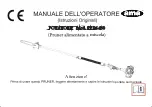
20
ENGLISH
CAUTION:
It may be necessary to slide the sliding
fence out to the required location or remove it to
ensure proper clearance prior to making the cut.
CAUTION:
Use a clamping position that does not
interfere with the cutting operation.
NOTICE:
You can quickly locate 0°, 15°, 22.5°, 31.6° and 45°
left or 0°, 15°, 22.5°, 31.6°, 45° and 60° right by releasing the
miter latch lever as you rotate the miter table. The table will
seat itself in one of the positive stop notches, located in the
miter table base.
2
1
Bevel cut (Fig. 29a-29b)
A bevel cut is a cut made across the grain of the workpiece
with the blade at an angle other than 90° to the miter table.
A straight bevel cut is made with the miter table set at the
0° position and the cutting head set at a bevel angle
between 0° and 48° left.
• Loosen the miter lock handle
by turning it counter-
clockwise and squeeze the miter latch lever.
•
Move the table to the desired angle.
• Release the miter latch and
tighten the miter lock
handle after adjusting the miter angle.
Fig. 27a
Fig. 27b
1
•
Align cutting line on the workpiece with the edge of
saw blade.
•
Turn the precision blade guide systems ON/OFF switch
on to project the blade shadow onto the workpiece.
•
Grasp the workpiece firmly with one hand and secure it
against the fence. Use the workpiece clamp or a C-clamp
to secure the workpiece when possible.
•
Before turning on the saw, perform a dry run of the
cutting operation to make sure that no problems will
occur when the cut is made.
•
Grasp the saw handle firmly. Turn the switch on and
allow several seconds for the blade to reach maximum
speed.
•
Slowly lower the blade into and through the workpiece.
Fig. 28
Crosscut (Fig. 28)
A crosscut is a cut made across the grain of the workpiece.
A straight crosscut is a cut made with the miter table set at
the 0° position.
Miter crosscuts are made with the miter table set at an angle
other than 0°, either left or right.
•
Loosen the miter lock handle by turning it counter-
clockwise.
• Set the table to the desired angle: refer to “Miter cut”.
• Release the miter latch and
tighten the miter lock
handle after adjusting the miter angle.
• Place the workpiece flat on the miter table with one
edge securely against the fence. If the board is warped,
place the convex side against the fence. If the concave
edge of a board is placed against the fence, the board
could collapse on the blade at the end of the cut,
jamming the blade. (See Fig. 34a-34b)
•
When cutting long pieces of lumber or molding,
support the opposite end of the workpiece with
extension table. (See Fig. 24b)
•
Release the switch trigger and allow the saw blade to
stop rotating before raising the blade out of workpiece
and removing the workpiece from the miter table.
•
Loosen the bevel lock knob at the rear of the saw.
•
For adjustments at any bevel angle, pull the lock button
Summary of Contents for CMXEMAX69434501
Page 2: ......








































